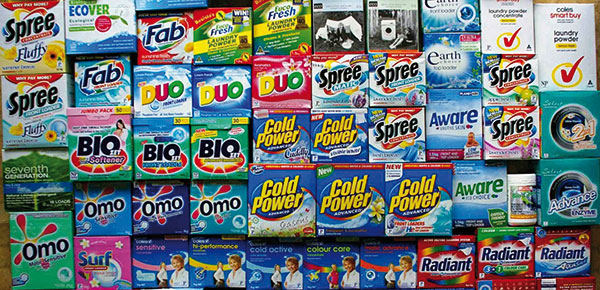Products for household detergency
THE FIGURES AND THE PACKAGING The “cleanliness culture” leads consumers to favor products for home detergency featuring a high service content (also in terms of time-saving) and high bactericidal functions; the exact differentiation in terms of specific use implemented by the big sector brands is among the factors that has led to the success of the same.
The range of chemical products for domestic use is very wide and includes laundry and dishwashing detergents and auxiliary products, detergents for dishwashers, surface cleaning detergents, products for cleaning and homecare (waxes, disinfectants, etc..), deodorants, insecticides etc.

The market
This market areas has shown growth trends substantially positive lasting for several years. All the same, according to an analysis made by Federchimica, in 2012 the demand for detergents saw a drop of 1.4% in quantitative terms, and a drop limited to 1% in terms of value, following a higher demand for concentrated products, which are higher priced.
In particular, the greatest drop was seen in washing adjuvants (additives and softeners), and insecticides (-2% ascribable to weather conditions unfavorable for their use, in the light of shorter summers) and surface cleaning products, down 5%.
Against this, washing machine detergents show an upturn (in particular liquid concentrates, compared with a decline of those in powder form) along with cleaning products for washing dishes by hand or in the dishwasher.
In terms of foreign trade, the analysis of data compiled by ISTAT in 2012 shows exports standing at 1,180 t/000 (approximately 49% of production), slightly down on 2011.
Imports stand at 560 t/000 (around +2% on the previous year) covering 3% of domestic demand.
Italian foreign trade is essentially implemented by big international companies located in Italy.
It is believed that also in 2013, the continuing economic crisis and its impact on income will induce households to buy only what is needed to “look after the home", which is likely to result in a further reduction in consumption. In particular, as already emerged in the course of 2012, there will be a substantial stability of the generally used “basic” products, while there will be a drop in washing additives, concentrates and, in general, products for specific uses.
At any rate one is dealing with a market on the way to maturity, but that is still active and vital, particularly in terms of product innovation.
Packaging chemical products for domestic use
Analysing the types of packaging used, one notes the predominance of plastic (bags, bottles etc.) followed by cellulose (cartons, drums etc.) and metal packaging (mainly aerosol cans).
As is the case throughout the chemical industry, the choice of packaging material is largely functional to the chemical-physical characteristics of the product to be packaged, but also depends on communication needs in order to differentiate the various trademarks and product innovations.
Among the main innovations of recent years the use of recycled plastics for the production of containers should be highlighted.
Another significant action has been the gradual reduction in the average weight of packaging.
With regard to the mix of primary packaging used to pack household detergency products, the largest share is held by plastic containers (currently estimated at 91.6%, 68% of which bottles, 21.6% comprised of bags and pouches made of flexible polylaminate converter packaging, 1% by flexible tubes, 1% by various wraps).
Flexible tubes are primarily used to contain creams for cleaning metal objects.
The significant presence of plastic packaging, with a potentially strong growth trend, stems from the following factors:
- the preference for laundry and dishwashing products in liquid and semi-liquid form to the detriment of powders;
- the progressive increase in the use of specific washing additives, generally in liquid form.
These trends have led to a drop in the presence of the cardboard carton.
As far as spraycans are concerned (with a global share of 1.7%), steel ones predominate. Their use is limited to insecticides (a field in which emanators are gaining ground), stain removers and dust eaters.
Over the last two-to-three years the vending machine has made its appearance, inducing a new type of consumption and, it goes without saying, a new type of “packaging”. Its presence in some largescale retail centers is still fairly limited (around 0.7%), mainly dishwashing and laundry products being involved. Its growth potential is potentially good.
Alongside the primary and secondary packaging we logically also find transport packaging in the form of corrugated cardboard boxes, heatshrink film and pallets.
Plinio Iascone
Istituto Italiano Imballaggio

















